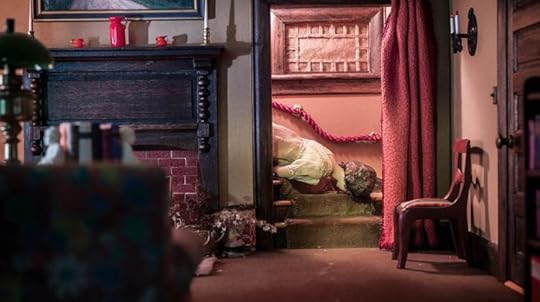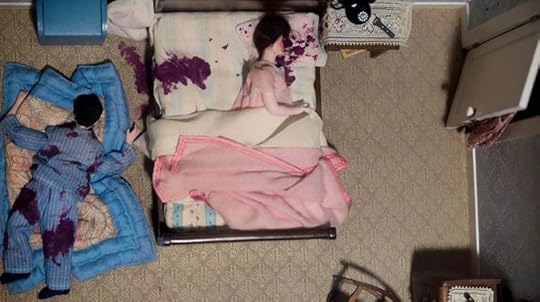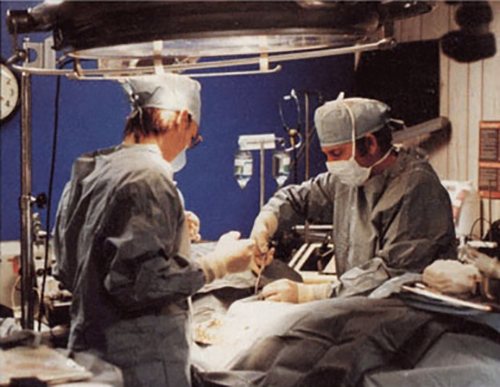Ripley Entertainment Inc.'s Blog, page 387
September 28, 2017
CARTOON 09-28-2017
September 27, 2017
Unexplained Death Dioramas from the 1940s
Featured in Ripley's Believe It or Not!

These 1:12 models of grisly murder scenes were handcrafted with exquisite detail. Each one was made to reflect real crime scenes from the 1940s.
The Mother of Forensic Science
The architect of all of these dioramas was Frances Glessner Lee, a wealthy heiress from Chicago. She was born into the family that owned International Harvester, but her true interests lie in solving mysteries.
She built the Nutshell Studies of Unexplained Death to aid in training police officers and crime scene investigators.
“To clear the innocent as well as expose the guilty. Seek only the facts—find the truth in a Nutshell.”

Frances Glessner Lee building a diorama.
Nutshell Studies of Unexplained Death
Forensics students were given 90 minutes to carefully study the details of the crime scene. The only things they could use were a small flashlight, magnifying glass, and their own deductive skills to solve the mystery.
Locked doors, working lights, object placement, and body orientation are all set with precise detail. To model these precise crime scenes, Lee even went to such great lengths as attending autopsies to properly reproduce the fabrics victims wore.
Despite being constructed in the 1940s, the dioramas have been so useful in teaching students to pay attention to detail, that they are still used today. For her work in the forensics field, Lee is known as the mother of forensic science and is even rumored to have been the inspiration behind Murder, She Wrote‘s Jessica Fletcher.









Images CC Lorie Shaull
CARTOON 09-27-2017
September 26, 2017
Cryonics: What It’s Like to Be Frozen
Featured in Ripley's Believe It or Not!

We’ve all heard the rumors of famous celebrities and world-elite freezing their sick bodies in the hopes of being reanimated in the far future when a cure is found for their illness. This practice, cryonics, relies on sub-zero temperatures to preserve these bodies in a state of suspended animation, but where does the science end, and fiction begin?
The First Frozen Man
The first person to be cryopreserved was Dr. James Bedford in 1967. Bedford was a psychology professor at the University of California with kidney cancer that had begun to affect his lungs. At this point in medical history, there wasn’t even a way to treat his condition. Just hours after he died, doctors from the Life Extension Society froze his body. Most cryonics researchers today believe that Bedford’s preservation was not viable, however, a chemical meant to aid in the preservation process was pumped into Bedford’s body, which physicians now think may have caused permanent damage to the brain, making it impossible to ever restore him.

Bedford being transferred to a new tank./CC Alcor Life Extension Foundation
In Bedford’s will, he left the Life Extension Society $100,000 to go towards research, but his wife and son used up more than that amount of money defending Bedford’s will in court. His body has since moved between five different facilities since his preservation, and was even kept by members of his family for a time.
Modern Cryonics
Whole-body cryopreservation continues to be regarded by the mainstream scientific community with skepticism. The big rift between scientific consensus and cryonic faith is the potential for the brain to be preserved long-term without sustaining damage. Surgeons today use cold temperatures to slow down the metabolic rate of the brain, making it tolerate oxygen deprivation for extended periods, but even that practice results in brain damage around the 40-minute mark.

Cryonics procedure./CC Alcor Life Extension Foundation
Since Bedford’s preservation, most cryonics advancement has been made in protecting the body from damage during the freezing process. Freezing the body in a way to keep ice crystals from damaging the brain uses cryoprotectants and vitrification. Vitrification allows liquids to freeze while staying in a softer, more fluid state, keeping ice crystals from damaging tissue. Despite these advancements, damage caused by cryopreservation of the human body is irreversible with modern technology and procedures.
The Process
To be cryopreserved in the United States, you first have to be declared legally dead. After that, you have to finance the process of careful freezing. This can cost anywhere from $28,000-$200,000 and is often paid for by life insurance policies, though you can get frozen for a little cheaper in Russia. Once you’re frozen, you are charged maintenance fees. This need for a possibly never-ending supply of money makes cryopreservation impossible for most people, though there has been a trend of just freezing your head to save money and space.
Though the stories of Walt Disney being frozen are, in fact, erroneous—Disney was cremated—Red Sox baseball player Ted Williams is probably the most well-known person to be cryogenically frozen.

Tedd Williams was cryonically frozen after death despite wanting to be cremated.
The Future
Many people may be awaiting revival in a far-flung future where tissue regeneration techniques and neurology are far more advanced, but some cryonics patients’ fate may not be so lucky. The Cryonics Society of California—a facility that held Bedford for a time—ran out of funding and lost 9 patients to thawing, a warning that even cryogenic preservation isn’t forever.

A modern cryonic storage container./CC JM Perez
CARTOON 09-26-2017
September 25, 2017
One of the Most Unbelievable Spots in America, Snake Alley!
Featured in Ripley's Believe It or Not!

Did you know, Snake Alley, one of the most unbelievable spots in America, sprawls on the Mississippi River in Southeast Iowa? Ideally situated in the community of Burlington, the regional center for employment, shopping, education, healthcare, and recreation, is the town’s most famous landmark.
Unbelievably Crooked
Here, at Ripley’s Believe It or Not! we are officially calling Snake Alley one of the most unbelievable, curious spots in America! But wait, WHY? Well, picture this: Snake Alley consists of five half-curves and two quarter-curves! Believe it or not, that spans 275 feet, which means the alley was quite complicated to build. Try riding your bike up that. Hold up, you can! The street is the site of an annual uphill bike race, the Snake Alley Criterium, held each Memorial Day weekend.
It looks like you just found your next epic adventure!
Snake Alley can be compared to those breathtaking yard paths you find in France or Germany since the road is made entirely of limestone and blue clay bricks.

Photo Courtesy of Don Weiss
History
The construction of Snake Alley began in 1894, however, the nickname, “Snake Alley,” wasn’t dubbed until a couple of years into the development. The early official maps referred to it simply as “6th Street.”
Many locals, such as William Garrett, filed a remonstrance with the city protesting the construction of the alley. The city explained to locals why the road needed to be constructed and why it needed to be built like a snake. See, it was part of an experiment to find the most convenient way to help horses and buggies to travel down.
Charles Starker, a German immigrant architect, and landscape engineer promoted the idea of a spiraling street in Burlington and helped design the alley. He also worked with William Steyh, a city engineer, who laid out the unusual street pattern.

Construction of Snake Alley Photo Courtesy of Don Weiss
Unfortunately, the town’s experiment was not as successful as they had hoped. Many horses would lose control off the top of the alley and trip over the limestone curbing, causing some to break their legs. Thankfully bricks were eventually laid at an angle to allow horses hooves to obtain a better grip.
By 1909, the alley became a hit with automobile traffic. So much, so that car dealers used Snake Alley for their test drives. Around the 40s, residents who lived along the alley were finally allowed to park inside of the curves.
Did you know?
Cost was assessed to the houses/buildings along the alley:
William Garrett (Garrett-Phelps House) paid $410.06
G.J. Reis, $129.49
P. Bouquet, $108.03
S. Leebrick, $215.87
E.D. Rand Estate, $431.53
J.K. Garrett, $215.87
The German Evangelical Church, $215.87
Total was $1,726.71
Do you know of any odd spots in the U.S.? Click here to let us know, it might just be featured on Odd Spots – Ripley’s Guide to the Curious Corners of America!!!
Source: One of the Most Unbelievable Spots in America, Snake Alley!
CARTOON 09-25-2017
September 24, 2017
CARTOON 09-24-2017
September 23, 2017
CARTOON 09-23-2017
September 22, 2017
London Sewer’s Fatberg and a Historic Treasure Washed Up By Hurricane
Featured in Ripley's Believe It or Not!

[September 17-23, 2017] A man climbs a frigid mountain in his boxers for charity, a hurricane unearths a historic treasure, and London decides to turn the fat in its sewers into bus fuel.
5. Man Climbs Mountian in His Boxers
Nathan French decided to raise £1,000 to fight dementia by climbing to the top of Snowdon mountain, the highest peak in Wales. He completed the entire climb in his superman underwear, but suffered from hypothermia on the descent and had to be checked by an ambulance.
Lad climbs mountain in only Superman boxers, ends up being treated for hypothermia. https://t.co/qqex0ILnrG pic.twitter.com/jEeTgAICVg
— LADbible (@ladbible) September 16, 2017
4. Fatberg Turned into Bio-Diesel
When fat and grease mix with wet-wipes and other non-flushable products in the sewer, you get what water management experts call a “fatberg.” These masses of congealed fat and fabric create problematic blockages in water systems. A 130-ton fatberg was located in the sewers of London last week. It weighs more than a blue whale, but workers have been using high-pressure hoses to break it up. Once removed, it will be turned into enough bio-diesel to power 350 double-decker buses for a day.

Via Thames Water
3. The Dadbag
The Dadbag is a fanny pack that doesn’t give you an extra spot to stow your wallet, but also gives you the distinguished belly of a dad. The designer is looking for partners to manufacture their bag, but promise soon you’ll be able to achieve the dadbod look without the health risks.
A post shared by Dadbag – The Original (@thedadbag) on Sep 15, 2017 at 7:22am PDT
2. Hurricane Irma Washes Up Dugout Canoe
During the cleanup after hurricane Irma in Florida, one man discovered a dugout canoe. The cypress boat seems to have been preserved by the brackish waters of the Indian River Lagoon. Local historical societies have already preserved the canoe in a water bath, and look forward to carbon-dating it and displaying it to the public.
1. The World Is Ending
In case you havent heard, the rapture starts this weekend. According to a biblical researcher and astrologist David Meade, the rapture will begin this Saturday as a “secret planet” passes by Earth. He predicted this event would happen 33 days after the last solar eclipse. NASA looked into the secret planet and says there is no cause for alarm. If you are worried and have pets, be sure to read our latest article on what happens to your pets after you ascend to heaven.
Rapture Pet Care Takes Care of Your Pets After the Apocalypse
Source: London Sewer’s Fatberg and a Historic Treasure Washed Up By Hurricane
Ripley Entertainment Inc.'s Blog
- Ripley Entertainment Inc.'s profile
- 52 followers










